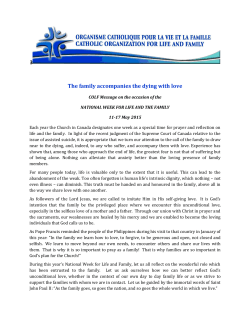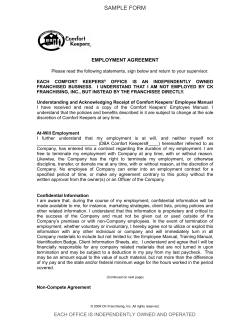
Care of Imminently Dying Patient ” Comfort Care Theresa Kristopaitis, M.D.
Care of Imminently Dying Patient ”Comfort Care” Theresa Kristopaitis, M.D. Objectives Explain physiologic changes that occur in the last hours/days of life Develop a treatment plan for the last hours/days of life Effectively communicate with the loved ones of dying patients My Perspective Time of intensive “caring” A Dying Patient in bed Flat, HOB elevated, sitting upright sleepy, unarousable, alert nonverbal, mumbling, moaning, verbally communicative breathing pattern “normal”, shallow, rapid, slow, apneic, Cheynne-stoking unable to swallow, swallowing bits of food or liquids or pills tachycardic, bradycardic hypotensive, hypertensive in pain, no pain We all live differently We all die differently No one quite takes the same road The “Usual Journey” Appetite Oral food/fluid intake Decrease/inability is normal Associated with many fears and misconceptions ?starve to death Reaffirm this is natural Well-being from secreted cytokines, catecholamines Parenteral fluids may be harmful New tubes generally uncomfortable What if they have a tube? Mouth care q 2 hours Swab, lubricant Loss of ability to swallow Swallowing is complex Sick, weak lose ability Natural Limit PO intake to avoid aspiration Sips of liquid if able Ice chips Saliva/secretion pooling – “Death Rattle” Bothers observers more than patients? Positioning Anticholinergics Scopolamine patch 1.5mg behind ear q 72 hours Glycopyrrolate 0.2mg IV Avoid suctioning Changes in Respiration Tachypnea Apnea Cheyne-Stokes respiration Accessory muscle use All or none or some of the above Changes in respiration Oxygen May relieve dyspnea May not relieve dyspnea May prolong dying process Discontinue Pulse Ox Checks! Titrate O2 to patient’s comfort Air hunger Opiates Repositioning Changes in respiration Explain to the family Last reflex breaths “Fish out of water breathing” Increasing weakness, fatigue Decreased ability to move Joint position fatigue Increased need for care reposition q 2 hours What about decubitus ulcers? Communication Issues Awareness>ability to respond Too weak to talk Assume patient hears everything! Communication “Near Death Awareness” Dying patients see and speak to deceased relatives and friends Prepare for travel Describe a place they see in another realm Nonverbal communication Touch, hand-holding “If they didn’t like touchy-feely and huggies before, they’re probably not gonna’ like it now” T. Kristopaitis Decreasing Perfusion Tachycardia, hypotension Peripheral cooling cyanosis Skin mottling Diminished urine output Parenteral fluids will not reverse Patients may die with “normal” blood pressures and pulses “Why is he/she sleeping with eyes open?” Loss of ability to close eyes Loss of retro-orbital fat pad Insufficient eyelid length Conjunctival exposure Lubricant Comfort Care Medications Limit to essential medications Comfort Does not mean “stop everything” Use clinical judgement for each individual patient and each of their medications Neurologic dysfunction 2 roads to death Confused Tremulous Restless THE THEDIFFICULT DIFFICULT ROAD ROAD Hallucinations Normal Normal Mumbling Delirium Sleepy Myoclonic Jerks Lethargic THE THEUSUAL USUAL ROAD ROAD Seizures Obtunded Semicomatose Comatose Dead Dead EPEC Comfort Care Pain Continue to treat if pain was an issue Dose, route adjustments Grimacing, groaning, moans May not indicate pain May err on the side of treating for pain Care for the Actively Dying Stop unnecessary procedures, monitoring d/c telemetry d/c pulse ox checks d/c accuchecks d/c TEDs and SCD’s Vitals daily and PRN (ie fever) ?Dobhoff tubes ?Nasogastric tubes Keep bladder catheter Keeping Vigil Individual decision Loved ones have to go to bathroom, eat, sleep, (smoke), work, take care of others Sometimes they need permission to do so Dying can be a private event The precise hour of death CANNOT be predicted Questions?
© Copyright 2025





















